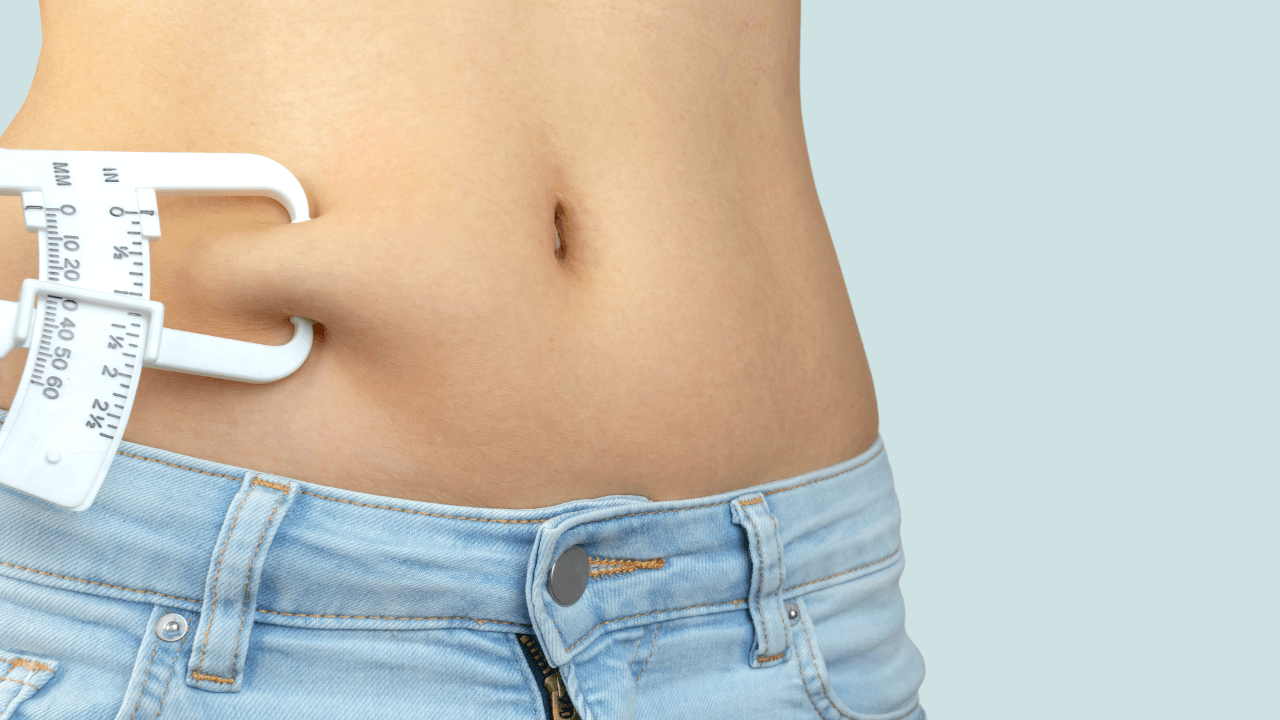
Losing body fat requires patience and a willingness to experiment with different strategies. With so much information available, it’s challenging to understand which method could be most effective for losing body fat percentage.
A healthier body fat percentage might keep you away from heart disease, metabolic problems, and other health-related complications.
Small modifications could make a big difference in your health and achieve a healthier body fat. However, each person’s body composition and metabolism are unique, which means that what works for one person may not work for another.
This article will discuss, in-depth, healthy body fat percentage and some of the best ways to reduce body fat.
Healthy Body Fat Percentage
-
Healthy Body Fat Percentage For Women
Physically fit women with higher muscle mass may have body fat percentages between 21-24%. Women should strive for a healthy body fat percentage between 25-31% to maintain optimal health and well-being. It is important to note that this range may vary depending on genetics, age, and overall body composition.
-
Healthy Body Fat Percentage For Men
Men’s healthy body fat percentage can range from 18-24%, with anything over 25% classified as obese. It is essential for men to maintain a healthy body fat percentage to rule out the risk of various health conditions.
Best Ways To Reduce Body Fat Percentage
-
Get Adequate Sleep
Sufficient sleep plays a vital role in achieving and maintaining a healthy weight. Lack of sleep might disrupt the balance of hormones that regulate appetite, contributing to increased hunger and a higher risk of overeating. This could contribute to weight gain and obesity.
Aiming for at least 7 hours of sleep per night is recommended to promote good sleep hygiene.
Making a regular sleep schedule, limiting caffeine intake in the evening, and minimizing the use of electronic devices before bed could also contribute to better sleep quality.
-
Consume Healthy Fats
Increasing your intake of healthy fats could be beneficial for weight management. Consuming a Mediterranean diet rich in healthy fats from sources like olive oil and nuts has been associated with more significant long-term weight loss than low-fat diets.
Limit trans fat consumption, which might lead to long-term weight gain, causing serious health complications.
Here are some examples of nutritious fats to include:
- Olive oil
- Coconut oil
- Avocados
- Nuts
- Seeds
-
Strength Training
Research reveals that resistance training for at least four weeks might help decrease body fat by an average of 1.46% and significantly reduce body fat mass and visceral fat.
A study conducted on adolescents with obesity found that strength training was more effective at reducing body fat than aerobic exercise alone.
Strength training could help preserve fat-free mass, which might increase the number of calories your body burns at rest. It could boost resting metabolic rate for increased calorie burn and weight loss.
-
High Protein Diet
Consuming protein-rich foods might reduce cravings and decrease calorie intake. Studies have found that increasing protein intake to 25% of daily calories could reduce cravings by 60% and cut late-night snack cravings in half.
A high-protein diet could support muscle repair and growth. It might prevent a decrease in metabolism that often occurs during weight loss.
Protein might increase feelings of fullness and satisfaction. This could benefit weight loss, as it might reduce the likelihood of snacking on unhealthy dishes and overeating.
-
Drink Healthy Beverages
Swapping sugary drinks for healthier options could effectively support long-term fat loss and improve overall health. Studies show that the consumption of sugar-sweetened drinks and alcohol may cause an increased risk of weight gain.
Research shows that drinking water before a meal could increase feelings of fullness, reduce hunger, and decrease calorie intake during the meal. Filling up the stomach with water before a meal triggers your nerves to send a stretch signal to your brain that you might not be as hungry, and it’s time to stop eating.
Healthy beverages like Green tea have caffeine and antioxidants that might increase fat-burning and boost metabolism.
-
Consume More Fiber
Soluble fiber in plant foods like fruits, vegetables, legumes, and whole grains could absorb water and help you feel full for longer.
Research has shown that increasing fiber intake could lead to increased weight loss and improved adherence to a healthy diet.
Another review study found that increasing soluble fiber intake significantly reduced body weight and belly fat, regardless of calorie intake. Fiber might reduce overall body weight and specifically target stubborn belly fat.
-
Avoid Fat-producing Chemicals
Fat-producing chemicals, also known as obesogens, can disrupt energy balance and contribute to the growth of fat in the body. They are found in bottles, containers, cleaning bottles, and medicine supplies.
It’s essential to be cautious of the materials used for packaging and storing food to avoid the adverse effects of fat-producing chemicals,
The following table provides an overview of familiar sources of obesogens and practical tips to minimize exposure:
Sources of Obesogens Tips to Minimize Exposure Non-stick cookware Switch to stainless steel, cast iron, or ceramic cookware Plastics Use glass or stainless steel containers instead for food storage Pesticides and herbicides Choose organic produce or wash thoroughly before consumption Artificial sweeteners Choose natural sweeteners like stevia or honey Hormones in livestock Choose hormone-free or organic meat and dairy products -
Increase Cardio
Cardio, or aerobic exercise, may help enhance fat-burning and promote weight loss. It might help reduce belly fat, waist circumference, and body fat.
Cardio exercises could increase your heart rate and oxygen consumption, which may promote fat-burning and help reduce overall body fat.
While cardio primarily targets fat burning, it may also preserve muscle mass. This is important because muscle is metabolically active and might help increase your resting metabolic rate, leading to more efficient fat burning.
-
Intermittent Fasting
Intermittent fasting is a diet pattern that includes cycling between periods of eating and fasting. It has shown potential for enhancing both weight loss and fat loss. Research indicates that intermittent fasting could be an effective strategy for reducing body fat.
Here are two modes of intermittent fasting:
- Alternate-day fasting: It may involve alternating between days of fasting and eating normally. A review of studies by Grant M Tinsley and Paul M La Bounty found that alternate-day fasting reduced body weight by 7% and decreased body fat by 12 pounds (5.5 kg) over 3-12 weeks.
- Time-restricted feeding: This approach could restrict your eating window to a specific time each day. One study showed that eating during an 8-hour window daily might help decrease fat mass when combined with weight training.
-
Increase NEAT
Non-exercise activity thermogenesis NEAT may refer to the calories burned during daily activities like cooking and cleaning. These activities might contribute to overall fat loss.
Research shows that people with low levels of NEAT have excess fat due to low physical activity and excess energy intake.
Small changes like taking the stairs instead of the elevator, parking farther away, or helping with household chores might increase NEAT and contribute to weight loss.
-
Drink Coffee
Caffeine could stimulate your central nervous system, boost the breakdown of fatty acids, and increase metabolism. It may help with calorie burning and suppress appetite. Research has shown that caffeine could enhance fat burning during aerobic exercise.
Another study showed that higher caffeine intake was linked with a higher success rate with weight loss maintenance. However, further studies are required to support coffee’s effectiveness in weight loss.
-
Try HIIT
HIIT involves brief periods of intense activity followed by short recovery periods. It might help you burn more calories compared to other types of exercise, such as running or cycling, in the same amount of time.
HIIT could maximize calorie expenditure. Studies have shown that HIIT might ramp up fat-burning and promote sustainable weight loss.
One review found that HIIT significantly reduced body fat mass and waist circumference after just 10 weeks of three HIIT sessions per week.
To integrate HIIT into your routine, you can try switching between walking and jogging or sprinting for 30 seconds at a time.
-
Cut Down on Refined Carbs
Refined carbs, such as pastries, processed foods, white bread, and breakfast cereals, undergo processing that strips them of their bran and germ, resulting in low fiber and nutrients.
Refined carbs contain a high glycemic index (GI), causing fluctuations in blood sugar levels that could increase hunger. As per a study, diets high in refined carbs may cause an increased belly fat over time.
Aim to follow a diet that may include whole grains, like quinoa, whole wheat, buckwheat, barley, and oats. Complex carbs and whole grains could lower body mass index (BMI) body weight and help with developing a smaller waist circumference.
-
Try Fermented Foods
Fermented foods like sauerkraut, kimchi, kefir, and yogurt contain beneficial bacteria that could populate the gut and promote a healthy microbiome. These bacteria may help in digestion, nutrient absorption, and immune function.
A healthy gut microbiome might effectively help in weight management. It may help regulate metabolism, reduce inflammation, and improve insulin sensitivity, which might lead to body fat loss.
-
Eat Probiotics Supplements
Probiotics may support weight loss, fat percentage, and BMI in the digestive tract.
One review found that people who took probiotics experienced more significant weight, fat percentage, and BMI decreases compared to those who took a placebo.
A small study also showed that probiotic supplements helped people following a high-fat, high-calorie diet prevent weight and fat gain.
Types of Body Fat
Body fat can be categorized into three main types: essential, subcutaneous, and visceral.
- Essential fat: It is necessary for the proper functioning of the human body. It may regulate hormones, body temperature, immune function, reproduction, insulin signaling, and nutrient absorption. Essential fat-soluble vitamins may rely on body fat for optimal absorption.
- Subcutaneous fat: It is often found in areas like the hips, thighs, and buttocks. While subcutaneous fat can contribute to a higher body fat percentage, it is generally considered less harmful to health than visceral fat. Subcutaneous fat could be pinched as it sits directly underneath the skin while cushioning joints and bones.
- Visceral fat: It surrounds the organs in the abdominal cavity. It is often referred to as belly fat. It is related to an increased risk of type 2 diabetes, heart disease, and other conditions. Visceral fat might secrete cytokines that could cause insulin resistance.
Who Shouldn’t Try To Lose Body Fat?
While losing body fat could improve overall health. There are certain people and health conditions in which losing body fat could severely harm health.
- Pregnant or breastfeeding: During pregnancy or after birth, the body undergoes considerable changes to support the growth and development of the baby. It is essential to prioritize the nutritional necessity of both the mother and the child during this time.
- Malnutrition: Malnourished people often have inadequate nutrient intake, which can negatively impact their health.
- Immunocompromised: People who have weakened or poor immune systems or are immunocompromised make it essential to prioritize their nutritional needs to support immune function.
Recommended:
Best Time To Reduce Body Fat
Gradual weight loss is recommended as it may lead to a greater reduction in fat mass and body fat percentage.
Generally, losing 0.5% total body fat per week or 2% body fat per month is safe. This could be equal to approximately 1 to 2 pounds of weight loss per week.
It is important to note that fat loss differs from overall weight loss. The number on the scale reflects a combination of factors, including body fat, lean muscle mass, organ weight, blood volume, and skeletal mass.
Frequently Asked Questions
- What Health Problems Come with Too Much Body Fat?
Having too much body fat might raise heart disease risk, type 2 diabetes, joint issues, and sleep apnea. - How Can I Find Out My Body Fat Percentage?
You could calculate body fat percentage using skinfold calipers, bioelectrical impedance analysis (BIA), dual-energy X-ray absorptiometry (DXA), or underwater weighing. - Can I Lose Fat in Specific Areas by Exercising Those Parts?
Targeted exercises might tone specific muscles but won’t directly reduce fat in that area. To lose fat, you should focus on weight loss through diet, exercise, and lifestyle changes. - How Does Aging Affect Where Body Fat Is Stored?
As you age, your metabolism slows down, and hormone levels change, which might lead to more fat accumulating around the abdomen. - Does Genetics Play a Role in Body Fat?
Genetics could influence body fat distribution. However, lifestyle factors like diet and exercise could be crucial. - What’s the Best Way to Reduce Body Fat?
To reduce body fat, eat a balanced diet of healthy fats, fruits, vegetables, lean protein, and complex carbs. Stay active, get adequate sleep, and manage stress. - How Long Does It Take to See Changes in Body Fat?
Noticing changes in body fat distribution may depend on health status, age, and metabolism. However, with consistent effort—like following a healthy diet and exercise routine—it might take several weeks to months to notice favorable changes.
Conclusion
Achieving a healthy body fat percentage requires a comprehensive approach that includes strength training, a high-protein diet, and sufficient sleep.
Focus on lowering your stress levels, as it might impact your body’s ability to manage a healthy weight. Hire a personal trainer and a nutritionist who could help curate a custom plan for your fat loss journey.
Losing body fat should be an enjoyable experience. Do not punish yourself or stay devoid of indulging in your favorite desserts occasionally.
However, if you still struggle to lose body fat after a consistent workout and healthy diet routine, talk to a doctor who could help you through the process and diagnose underlying problems.
- The information in this article is for informational purposes only and should not be considered medical advice.
- It is not recommended to disregard/delay seeking professional medical advice or treatment because of what you read or accessed through this article.
- The results may vary from individual to individual.
- Consult your doctor for any underlying medical conditions or if you are on any prescribed medicines before following health tips or instructions.


![ZipSlim Reviews : Results, Side-Effects, Alternatives [Warnings Update]](https://ispcs.com/wp-content/uploads/2024/04/ZipSlim-Reviews-300x169.png)
![PhenGold Reviews: Is It Another Fat Burner Scam? [Results]](https://ispcs.com/wp-content/uploads/2024/04/PhenGold-Review-300x169.png)

![TrimTone Reviews: Is It Another Fat Burner Scam? [Results]](https://ispcs.com/wp-content/uploads/2024/03/TrimTone-Review-300x169.png)





